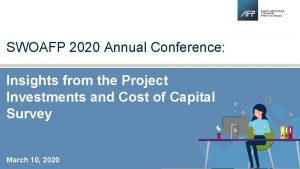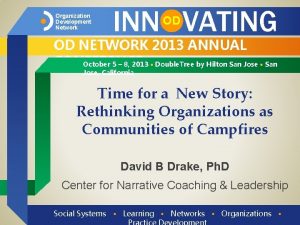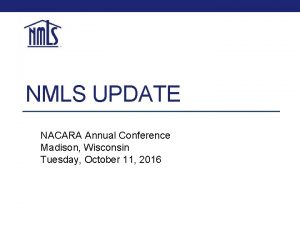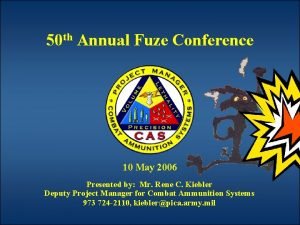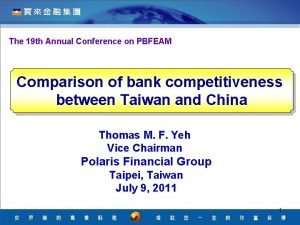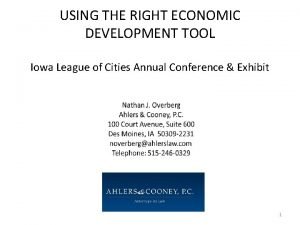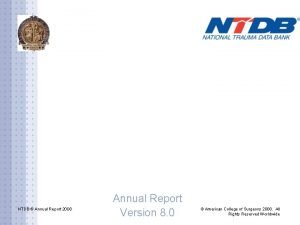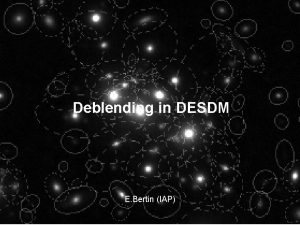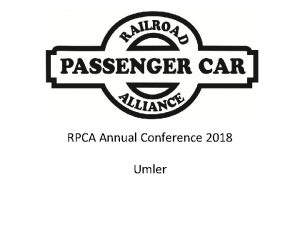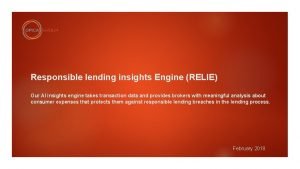SWOAFP 2020 Annual Conference Insights from the Project


































- Slides: 34

SWOAFP 2020 Annual Conference: Insights from the Project Investments and Cost of Capital Survey March 10, 2020

Agenda • • • Overview Findings: How we analyze projects A unifying theory Findings: Drivers of Success Q&A

Introductions About AFP National About Me Not-for-profit association committed to advancing the success of its members and their organizations. 20+ years in FP&A, Treasury, and Risk Create and curate content 3

Overview Areas of focus: • The process of project decision making • Updated AFP 2013 Cost of Capital Survey research Goal: • Help practitioners calibrate relative to industry practices www. afponline. org/fpasurvey

Overview 622 Responses www. afponline. org/fpasurvey

Time Is Getting Short Shrinking cash flow periods and less use of terminal value (TV) Length of Explicit Cash Flow Forecast Used in Valuations Use of Terminal Value in Valuation 79% 63% 5 yrs or less 2019 2013 Larger companies were more likely than smaller ones to use TV, 54% versus 43% 6

The Most Common “Financial Valuation” Metrics Are Not Valuation 7

What is Strategic? — “Non-financial benefits outweigh the financial loss. ” — “Strategic customer influence. ” — “Long-term vision and safety. ” — “Brands building and awareness. ” “The word ‘strategic’ a weapon of mass distraction…when the numbers don’t fly, ‘strategic’ becomes the justification for overriding numbers. Strategic can become a substitute for the kind of analysis that should precede a big investment. ” — Professor Aswath Damodaran 8

Neutral / Negative Financial Returns 30% or more all projects are nonpositive financial returns

Payback 10

Payback • Should be included already • Risk management • Payback might be company’s way of saying they don’t trust the projection 11

An Over-Abundance of Metrics # of Financial Metrics Used in Decision. Making # of Non-Financial Metrics Used in Decision-Making 33% 43% 12

Over the past 5 years… Cost of Capital “There is lots of consistency from 2013 to now, in terms of the calculation methodology and how it was applied…” Hurdle rate is unchanged 67% Application of hurdle rate unchanged 82% 13

Cost of Capital “…but consistency is not always a good thing because the world has shifted. ” • In the 20 th century in the US, you could get away with “set and forget” cost of capital • We don’t live in that stable world anymore Risk premium jumps 2 -2. 5% in 3 months 14

Cost of Capital “A wellconstructed cost of capital for a company should never be a constant for the whole year or worse still many years. ” WACC reviewed seldom Practitioners using historical rates • • 57% use current capital structure 62% use the raw (historical) beta 62% use an equity risk premium below 5% 72% use current book or market rates for debt to equity ratio

A theory We can perform more analysis … so we do

A theory Majority Capex v Majority Opex We perform more analysis Majority of projects has shifted to opex 47% 31% 21% Capex Group Equivalent Opex Group

A theory Majority Capex v Majority Opex We perform more analysis Majority of projects has shifted to opex 62% 59% 41% 40% • Smaller projects • Shorter duration • Minimizes use of Co. C Projects < $1 M Duration < 12 Months Capex Opex

A theory We perform more analysis Majority of projects has shifted to opex • Different set of metrics

A theory We perform more analysis Majority of projects has shifted to opex • Different set of metrics

A theory • We perform more analysis • Majority of projects has shifted to opex • • Shorter duration Smaller projects Minimizes use of Co. C Different metrics • Project investment analysis is becoming more agile • Except regarding Co. C

What to do Focus on Process

Process Rigor Correlates to Success “What percentage of projects initiated in the past three years would you estimate are on schedule or fully implemented and considered successful? ” 23

Process Rigor Correlates to Success Drivers of success: Good process How satisfied are you with your role in the following elements of project investment management? (Those who responded 4 or 5) Sourcing ideas 31% 28% Business case development, excluding financial modeling 32% 41% 51% Financial modeling Evaluation of projects/go or no-go decision 42% Reporting on project performance 48% 46% Post project reviews/Project value tracking 24% Low Success 38% High Success 51% 63%

Process Rigor Correlates to Success Drivers of success: Management has “skin in the game” Are business owners generally accountable for project success through incorporating project financials into their plan/budget? 64% 38% Low Success High Success

Process Rigor Correlates to Success Drivers of success: Operational diligence Do you conduct a review of projects after completion to ensure benefits and learnings are received? Responding “Usually” or “Often” 78% 65% Low Success High Success

Process Rigor Correlates to Success Driver of low success: Lower use of financial analysis What percentage of projects are approved without positive financial returns? Low Success 46% High Success 34% 27

Process Rigor Correlates to Success Poor Elements of Process What drives low financial analysis? 28% 21% 17% 10% * Strategic importance correlated to high success Influence of Senior Execs Low Success No financial analysis required High Success

Inconclusive Does the choice of financial analysis correlate to success • Capex projects overrepresented in the high success group • Associated Capex metrics were also overrepresented: • NPV, ROI, Payback, IRR • Also Contribution Margin 29

30

Additional Resources: https: //bit. ly/2 V 2 OTKY 31

What is Agile? Self-described Agile organizations have some expected qualities…

What is Agile? Self-described Agile organizations are satisfied…

What is Agile? …but are they really Agile? • • No change in termination rates Less likely to say “VC” model is effective
 Afp annual conference 2020
Afp annual conference 2020 What is vating
What is vating Problemitize
Problemitize Hepi conference
Hepi conference Nmls resource center
Nmls resource center Gie annual conference
Gie annual conference Annual fuze conference
Annual fuze conference Pbfeam
Pbfeam Travel health insurance association annual conference
Travel health insurance association annual conference Gcyf 2011 annual conference
Gcyf 2011 annual conference 2017 dvhimss annual fall conference
2017 dvhimss annual fall conference Iowa league of cities annual conference
Iowa league of cities annual conference Stfm conference
Stfm conference Stfm conference
Stfm conference National trauma data bank annual report 2020
National trauma data bank annual report 2020 American psychiatric association annual meeting 2020
American psychiatric association annual meeting 2020 Revised annual teaching plans 2020
Revised annual teaching plans 2020 Revised annual teaching plans 2020
Revised annual teaching plans 2020 Spring io conference 2020
Spring io conference 2020 Mip conference 2020
Mip conference 2020 Ansys conference 2020
Ansys conference 2020 Alzheimers nz conference 2020
Alzheimers nz conference 2020 National conference for rabi campaign 2020
National conference for rabi campaign 2020 H2fc supergen conference 2020
H2fc supergen conference 2020 Desdm
Desdm Hình ảnh bộ gõ cơ thể búng tay
Hình ảnh bộ gõ cơ thể búng tay Frameset trong html5
Frameset trong html5 Bổ thể
Bổ thể Tỉ lệ cơ thể trẻ em
Tỉ lệ cơ thể trẻ em Chó sói
Chó sói Thang điểm glasgow
Thang điểm glasgow Chúa yêu trần thế
Chúa yêu trần thế Các môn thể thao bắt đầu bằng tiếng đua
Các môn thể thao bắt đầu bằng tiếng đua Thế nào là hệ số cao nhất
Thế nào là hệ số cao nhất Các châu lục và đại dương trên thế giới
Các châu lục và đại dương trên thế giới
